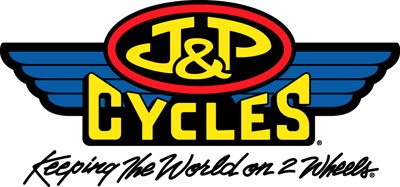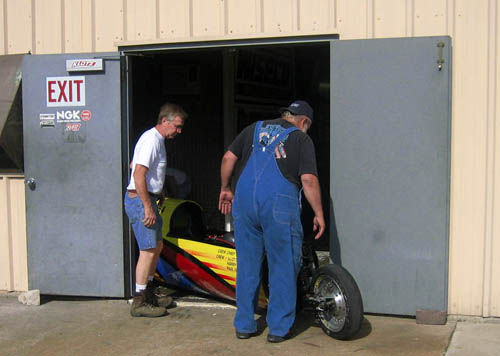
Sunday, July 8th, Jeff Wiley, Mike Shafer and I went to Scott Minzenmeyer’s shop, Recreational Motorsports to dyno test the J&P Cycles Express. The motor we tested was what we call “the little motor”. Actual displacement is 80.07 cubic inches, or 1322 CCs. We planned to run against our own 1350 CC AMA class record of 178.948 and an open 1350 CC FIM class record.
See the first report, click here:
We arrived at the shop at 9 AM, and unloaded. Careful manipulation got the liner backed into his dyno cell, and we where able to close the outside doors. Based on the length of the bike it was feared a portion would be left outside. Most dynos, used frequently these days, are the Dynojet type. It measures power by timing how long it takes to accelerate a mass (an accelerometer).
The Dyno we used is a true pump type dyno that measures the power required to pump water over a given amount of time. Fortunately we can vary the load on the water pump type dyno. The rear wheel was removed and the dyno pump was installed using the custom brackets Scott M. fabricated last year specifically for this application. Scott experienced this application previously, so it was a breeze. I hooked up our Edlebrock data acquisition system and verified calibrations. By this time it was 11:30 and we took a quick lunch break.
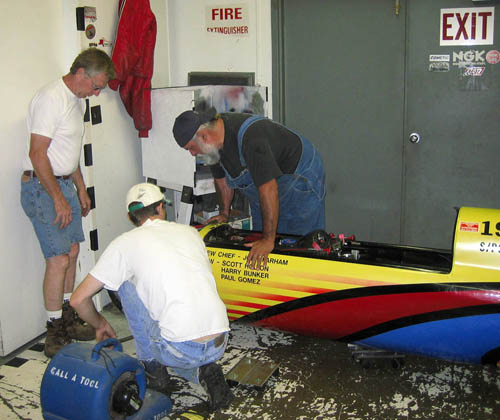
After lunch we fired the engine up for the first time, and warmed it up. We did a dyno calibration run so the dyno could calculate the gear ratios. We checked things out and made the initial pull. It read 60 horsepower. Needless to say, we were damn disappointed. Turns out the throttle cable had slipped during the run only allowing the butterfly to open ¼ of the way. Easily remedied, we tried again. Much better this time… 105 HP at 7250 RPM.
Reviewing the Edelbrock Quickdata readout, we discovered a lean setting in the midrange. Jeff and Terry N discussed things and made a change in the main jet (82 to 86) and added more fuel in the Thunder-jet (145 to 155). We made a pull and improved significantly in both torque and HP through the midrange. Due to operator error, we did not collect data output (turn it on, Scott). Ok, try again…
This time the motor was very hard to start, both O2 readouts showed as lean as they can go… The Kinzler fuel shut off pin had slipped and cut the fuel supply. Put pin back in, turn on the pump, fuel problem gone. During this time the rear pipe appeared to loosen up. Jeff grabbed the correct size Allen socket, puts the wrench to it and we heard, “tink.”
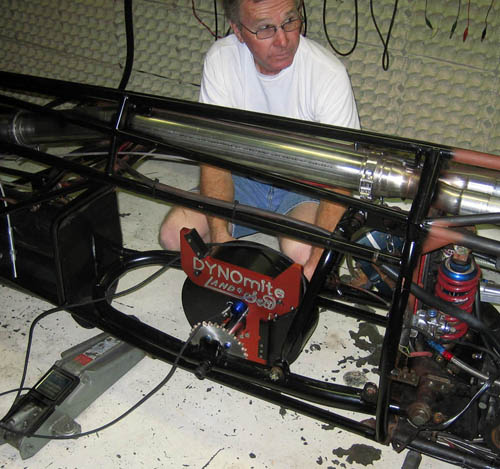
“I don’t like that,” Jeff said. He switched to the other side of the flange and, “tink” again. The flange broke off the pipe. Amid curses, the rear pipe was removed and discussion ensued regarding the repair. Rather than return to J&P to fix it, Scott’s MIG welder was pressed into service and another problem overcome.
Time to try again. This time despite our best efforts, the engine would not start. We check compression and scrambled through all the normal troubleshooting steps. No go. Jeff looked carefully at the ignition output and we decide to grab our backup unit. However, it was located back at the J&P shop, 30 miles away. Terry and Jeff headed off to retrieve it.
While they are gone, Scott and I decide to run the valves to insure the problem doesn’t lie there. Front Exhaust, OK. Front Intake, fine. The Rear Intake was good, and the Rear Exhaust pushrod was loose to the point the valve wouldn’t open. I adjust it up (a time consuming process due to the location and parts combination) and reinstalled the pushrod clips. Scott and I attempt to start it and were rewarded with a quick startup. As we adjusted the idle, Terry and Jeff returned.

After explaining what we found, it was time for another nail-biting run. This time, HP & torque numbers increased and the effort started to look promising. Another attempt, back to no starting. Jeff checked valve adjustments, and another pushrod was loose. We adjusted it and checked all four again, back to it. About this time, the O2 sensors became erratic. Because of this indication, for the remainder of the day we depended on EGT for an indication of the tuning. We made a few more runs with occasional jetting changes and decided we had enough.
Over all, we felt the day was very successful. Top HP for the day was 115 at 7250, and we had MONSTEROUS torque numbers for a small 80-inch Sporty Motor. The run that produced the best torque indicated 99.24 feet pounds at 3500 RPM, with a max of 115.1 feet pounds at 4750 RPM. At 5500 it dipped below 100 to 98.77 foot pounds. Basically that was 100 ft lbs or better for 2000 RPM!
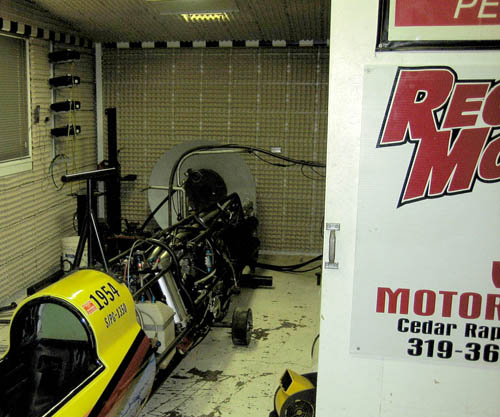
We witnessed some issues pulling through the higher RPM ranges that Jeff was going to discuss with the crew at Zippers (Thunder-jet questions). We discovered a bad batch of pushrods. They wouldn’t hold their adjustment. We need to manufacture better exhaust flanges. Our weather station worked well? The O2 sensors were designed to be used in unleaded fuel applications, and may have become erratic due to leaded fuel use. I was told new leaded fuel sensors should last about 10 hrs before requiring replacement. I planned to call Daytona Twin Tech (the supplier) to see what they recommend. We learned a lot and determined good baseline to tune from. There was more available hp in the motor.
Hang on for the next chapter at the Great White Dyno at Bonneville 2007.

